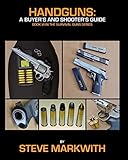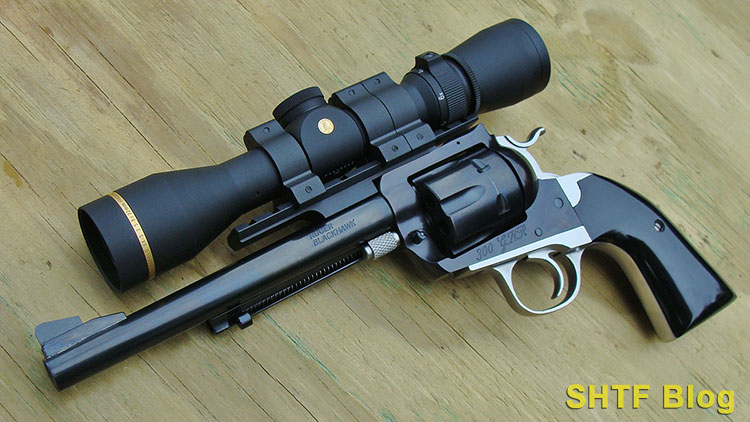
Handgun scopes are not something every shooter wants to mount, but there are some instances where mounting a scope to a handgun just makes sense.
A Background with Groundhogs
During the late 1980s, there were no turkeys in my area, but we did have woodchucks. After a long cold winter, they provided a good opportunity for some outdoor adventures before spring fishing reached its prime. Woodchuck time was early May, which also coincided with the beginning of our motorcycle season.
I managed to combine both pastimes by hopscotching around the area, in search of newly emerging “groundhogs.” Two wheels pose challenges if transporting a classic varmint rifle, so instead, I went with a handgun, carefully lashed to the bike’s rear rack in a padded case.
However, I wasn’t the only one traveling the backroads. Others employed drive-by tactics, which resulted in vehicle-educated survivors.

Passing traffic would be ignored, but any pickup that came to halt received close scrutiny from a bolt-upright woodchuck near its den. Inevitably, the first sight of a human would cause a rapid dive and lengthy underground hiatus.
One of my favorite fields was shielded from the road by a short uphill section that then tumbled down a long slope of several hundred yards. Every time I parked and crested the rise, one wary old ‘chuck would already be at full attention ion its burrow, 250 yards below.
Most are wary enough to require shots of one hundred yards or more, but this old-timer was gone as soon as our eyes made contact. The solution was Operation Chuck. I pulled over in the usual spot and parked the bike.
Instead of entering the field, I executed a downward sneak through the woods with the handgun slung over my shoulder. After guesstimating I’d passed below Chuck, I low-crawled into the edge of the field and, sure enough, there stood Chuck, fully upright and staring uphill, at 120 yards.
It would’ve been a difficult shot with iron sights, and challenging with a dot, but crosshairs are more precise. After placing a homemade rest under the pistol in prone, I held the wavering crosshairs high on the woodchuck’s back, cocked the pistol’s hammer, and applied pressure to the trigger. When the shot finally broke Chuck piled up in a heap, unaware of what had hit him.
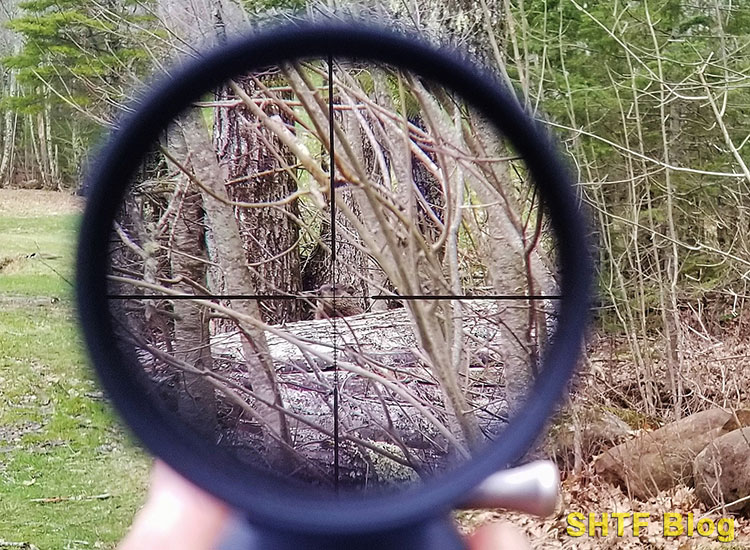
My handgun was a single-shot Thompson/Center Contender, a popular design that helped redefine long-range handgun performance. The T/C appeared in the late 1960s as an innovative break-barrel handgun that featured interchangeable barrels, in a number of popular calibers.
My small-farm, two-wheeled, woodchuck rig was a 10-inch .22 Hornet barrel with a Leupold 4X Pistol Scope, sling. T/Cs were known as tack-drivers and mine was no exception. Using 46-grain Winchester JHPs, it would routinely group five shots into an inch at 100 yards.
The Handgun Scope Wave
The T/C .22 Hornet was a lot of fun, but it was already a bit dated by the late ‘80s. A growing assortment of other interesting calibers had joined T/C’s barrel list, including some for centerfire rifles. Several were potent “wildcats” designed expressly for the T/C, using modified .30/30 or .444 Marlin brass. Previously, most “powerful” handguns were .44 Magnum revolvers or .45 ACP semiautos.
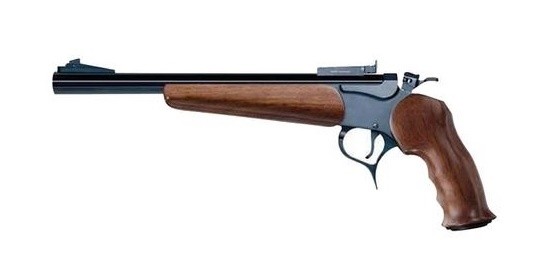
With some notable exceptions, the typical long-range handgun shot was fifty paces. The appearance of the T/C quickly stretched that distance, along with a few other nontraditional “handguns.” Remington’s futuristic XP-100 bolt-action debuted with a hot-rock varmint cartridge, the .221 Remington Fireball. Suddenly, “long range” meant 200 yards or further.
These distances called for better aiming systems and the timing was good. Rifle scopes had recently gone mainstream, so the optical manufacturers saw openings for new handgun sales. Previously, experimenters had been jury-rigging rifle scopes to handguns atop longer-barreled revolvers. As revealed during these efforts, durability and adequate eye relief were ongoing concerns.
4 Special Handgun Scope Considerations
The typical rifle scope is designed to present a full image when positioned 2 ½ -4 inches ahead of the shooter’s eye. If moved further forward, the image will begin to narrow until it blacks out, somewhere well before full arm extension. Optical engineers went to work and came up with solutions.
1 – Eye Relief & Magnification
Today’s pistol scopes feature “long eye relief” to accommodate typical handgun use. One trade-off is a much smaller field of view (the area seen in the scope). Lower magnifications can offset this issue to some degree, while also mitigating a psychological problem; the visual distraction of our own wobbles.
2 – The Shakes
We all have built-in wobbles, but they’re much less noticeable with iron sights. Even a 2X pistol scope can be intimidating because tremors appear to double. This was, and still is, a mind-blower for first-time handgun scope users.
For nearly everyone, effective shooting beyond 4X becomes a true exercise in concentration! Most handgun scopes of greater magnifications are variables, and many will be used with a support.
3 – Mass vs Recoil
The appearance of custom T/C barrels included some truly potent cartridges like the .375 JDJ. For good reasons, they’re often referred to as “hand cannons.” Stiff recoil doesn’t play well with larger scopes but, as shooters soon discovered, even smaller versions can encounter problems. The best insurance was, and still is, a quality scope secured in a suitable mount.
4 – Mounts
Beyond Long Rangers, one group of shooters that embraced pistol scopes early on was NRA bullseye shooters. Low-magnification handgun scopes eliminated sight-alignment errors, and fuzzy front sights became a non-issue. Since most handguns weren’t equipped for optics, all sorts of aftermarket mounts popped up, including some truly Rube Goldberg contraptions.
Remington’s XP-100 was the opposite thanks to its M-600 carbine lineage and factory-drilled receiver. Scoping a T/C was equally easy because each barrel was factory drilled and tapped, perfect for interchangeable barrels.
But, stiff recoil caused many a scope to slip in its rings, or even shear its screws. For this reason, mounting systems designed for heavy-hitting calibers sometimes incorporate additional rings. Success entails following the instructions for thread sealants and necessary torque.
Handgun Scopes at Work
Handguns equipped with target sights often have front sight blades thick enough to obscure much of a large combat silhouette target at 100 yards. Smaller targets may completely disappear behind the sights, making hold-over for bullet drop a guessing game.
Add a scope – even a 1X type – and the problem is eliminated via precise crosshairs. At 2X, the wobbles will appear greater, but the target will look twice as large (or half as far). More magnification can be useful for smaller targets, which accounts for my 4X woodchuck choice. Prairie dogs are smaller yet, and often shot at further distances. Thus, greater magnifications have value – if employed with stable rests.
Many of today’s handgun scopes are variable-power, possibly due to the overall popularity of these designs. That said, Leupold still catalogs a 7-ounce, 4×28 FXII Handgun Scope, with 18-inches of eye relief. Their other listing is a 10.9 oz. variable, the VX-3 Handgun 2.5-8×32, with 15 inches of eye-relief.
Don’t confuse handgun scopes with “intermediate eye relief” versions, such as Leupold’s Freedom 1.5-4×28 IER Scout. Designed to mount forward of a rifle’s receiver, its eye relief is a much shorter 6-inches. Unless you’re built like a fire hydrant you’ll need a true handgun scope and, even then, not every model will fit every shooter. If in doubt, assume a normal shooting position (for most, two-handed or possibly prone) and have someone measure the distance from the rear of your wrist to your eye.
Assuming you wind up with a variable, nothing says it has to be used on its maximum setting. You could start at a lower setting while gaining confidence with your system. The first attempt could be daunting, but it’s doable, nonetheless.
Technique
An experienced handgun buddy expressed interest in my T/C .22 Hornet system, so we stapled a white paper plate to a target backer at 30 yards. Peering through its 4X scope, he was less than encouraged by the wandering crosshairs.
Knowing he had mastery of trigger control, I asked this simple question: “Are your crosshairs wandering within the plate?” A bit of trial-aiming indicated they were, so the remainder of the process went as follows: Apply steady pressure to the trigger as long as the dancing crosshairs are surrounded by the plate. At some point the shot will break. If the gun is sighted in, you’ll have a hit.
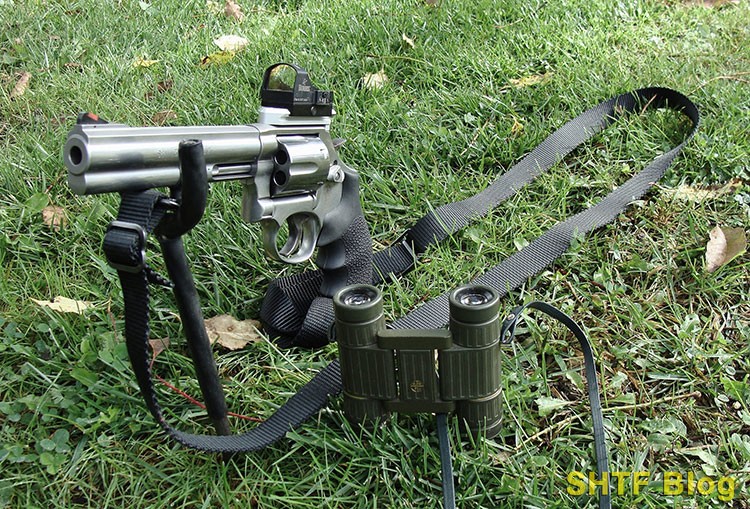
Not only that, it’ll probably be more centered than you’d expect. In fact, much more centered! Worked like a charm for my buddy, but cost me about a half a box of ammo.
This session involved offhand shooting. To take full advantage of a scoped handgun, you’ll need some sort of rest. Stationary claybirds and beverage cans will then be in mortal danger at 100 yards – or further.
Supports, Slings, and Carry Methods
Handgun scopes are certainly not something for inclusion into our list of conceal carry tips. That’s fine, it doesn’t need to be. Most of the handguns you would mount a scope to are not the types of handguns you would use for conceal carry anyway.
Operation Chuck succeeded thanks to my simple homemade rest consisting of a foot-long chunk of 3/8” steel rod. A separate U-shaped piece is welded to one end, and all surfaces except the lower 6-inches are sheathed in rubber wiring insulation. The bare end has a pointed tip which can be driven into soft earth.
Although it only works from prone, this low-tech support carries nicely in a small nylon belt pouch with a hole through its bottom – and it’s a whole lot simpler than a bipod.
Assuming you have way to mount one, a folding bipod will provide great stability. But, to my mind, it compromises the main advantage of a handgun; ease of carry. Add a scope and your system becomes downright “big.”
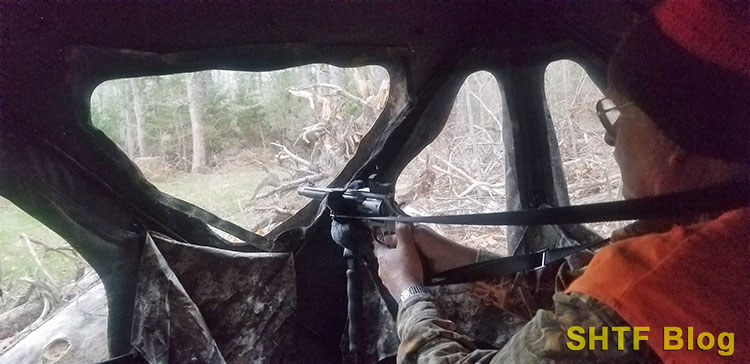
That said, a scope alone can be manageable, either through use of a cross-chest holster – or use of a sling. I prefer the latter method, which also provides additional support.
At full arm extension with a two-point sling looped around my neck, the wobbles decrease. By adding a set of shooting sticks, the system becomes downright deadly; not as stable as a bipod or my prone-thingy, but good enough for deer at 75 yards (or further). Confirm your zero per your shooting method!
Handguns and Scopes Generally
At one point I owned two T/C Contender frames and collection of scoped barrels in calibers from .22 LR through .35 Remington. Other handguns included a super-accurate 14-inch XP-100, chambered for .223 Remington, but mechanical accuracy doesn’t always translate to practical accuracy.
The XP-100 was large enough to create carry hassles, and offhand shooting was tricky. With the motorcycle now gone and woodchucks much scarcer, based strictly on practicality, a smallish rifle makes more sense. Thus, my ATV and truck gun is a 20-inch, .223 bolt-action, Remington Model Seven. It’s handy on foot, and a better match for our predominant new varmint; the large eastern coyote.
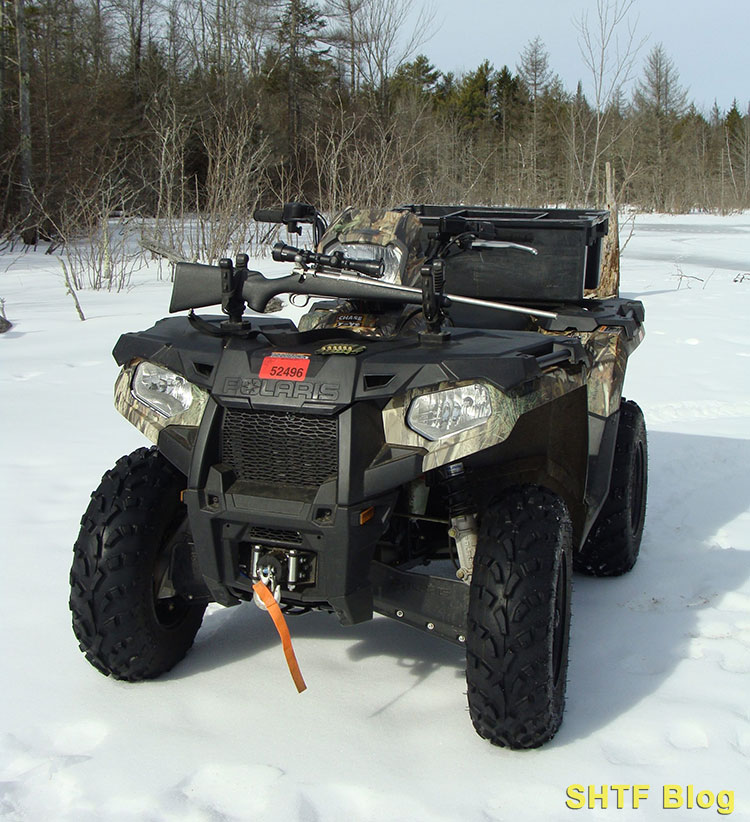
Conspicuously absent is the mention of AR pistols, or other larger-sized “handguns” sold today. Many are equipped with pistol-braces, and used more like rifles, meaning they’ll work better with rifle scopes. As long as the braces remain legal it’s the better choice. If not, I’d switch to a dot sight.
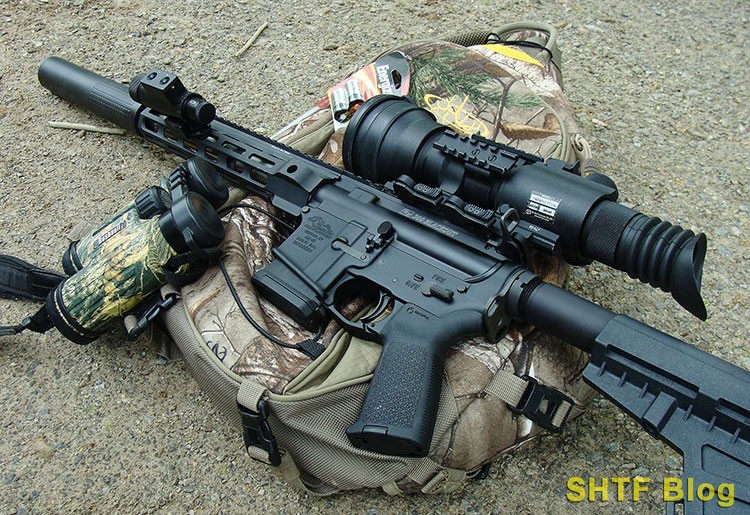
Final Thoughts
All of my scoped handguns have departed, but I’m still a believer in optical aiming systems. And, fortunately, today’s handguns are a whole lot more accommodating.
Like many others, I’ve embraced the red dot wave. A few are mounted to optics-ready pistols configured for defense. But, others are secured to decidedly sporting-type revolvers.
The latter are .357 and .44 Magnum S&Ws, which now come factory drilled for easy attachment of bases. This feature also extends to a number of .22 rimfire pistols makes, and it’s a feature worth shopping for.
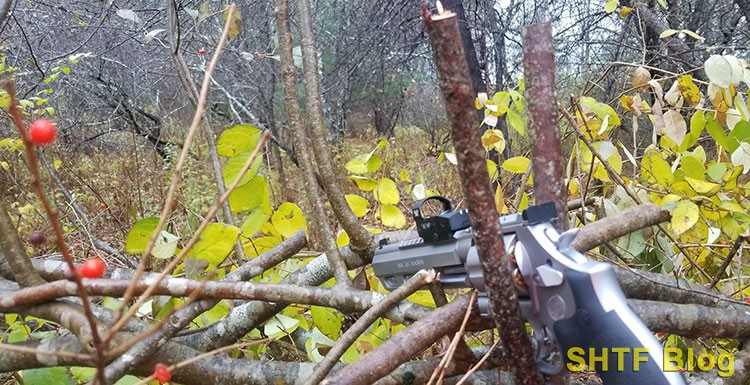
My switch to dot sights eliminates eye relief issues, while reducing recoil-mass and overall gun weight. But, there are times when I miss the precision of a scope. A buddy has a 2X Leupold mounted to his S&W .41 Magnum revolver and it’s deadly in our woods from enclosed deer blinds.
On hand here is an inexpensive bolt-action .22 LR chipmunk handgun with a 10 ½” barrel. Even with a dot-sight, it’s accuracy is phenomenal. Makes me wonder what it could do with a 4X pistol scope! Guess I’ll need to find out since it’s already rigged for a sling.
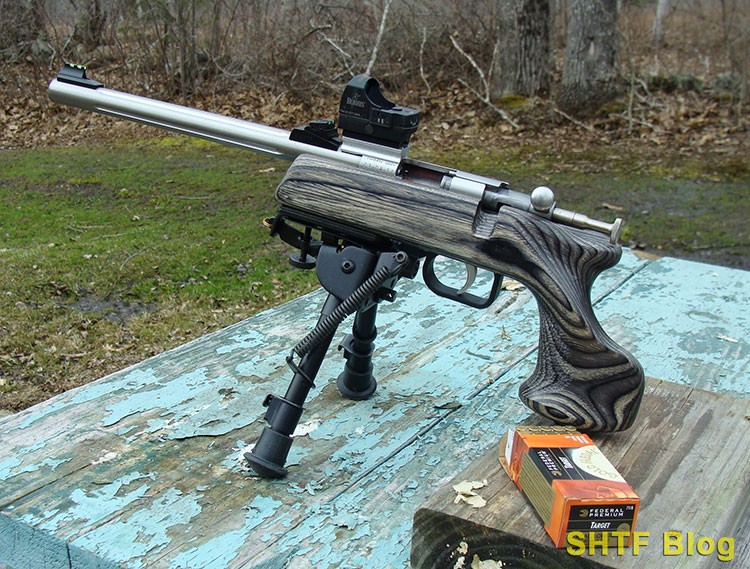
Steve Markwith is the author of the Survival Guns series of books, which includes one book devoted entirely to handguns.
- Markwith, Steve (Author)
- English (Publication Language)
- 418 Pages - 07/13/2019 (Publication Date) - Prepper Press (Publisher)
